Sermon - JUNGIAN TRANSFERENCE IN REAL LIFE -
Images from the Rosarium Philosophorum
© Barbara F. Meyers 2002. All Rights Reserved.
A
sermon delivered at the Mission Peak Unitarian Universalist Congregation on
August 27, 2002 by Barbara Meyers and Jackie Porter
Sermon - Jungian
Transference in Real Life: Images from the Rosarium Philosophorum
This service had its
inception in a class that I took at seminary entitled "Introduction to
Jungian Thought". The final paper that I wrote for this class was an
extremely revealing and rewarding experience for me, and this will form the
bulk of the sermon today. I'll begin with a brief biography of Jung.
Brief Biography of Jung
Carl G. Jung was born in 1875 in Switzerland. He was the oldest child of a
Swiss Reform pastor, who had a variety of pastorates in Switzerland throughout
Jung's childhood. The picture that Jung in his youth is that of a solitary,
bookish intellectual, puzzled by religious and philosophical questions and
curious about the world. After completion of high school Jung enrolled in Basel
University studying medicine and became interested in psychology and
psychopathology. He soon realized that psychiatry was his destined field. In
1900 he assumed an appointment as an assistant at a mental hospital in Zurich.
The work of Sigmund
Freud exerted a profound influence on his thinking. After corresponding with
Freud for several years, Freud invited Jung to visit him in Vienna in 1907. The
two men were greatly attracted to each other, and at their first meeting, they
talked continuously for 13 hours, beginning a personal and professional
relationship that was to last for six years. Freud regarded Jung as his crown
prince and successor. However, Jung was an independent person and wished to
pursue his own line of thought, eventually leading to a complete break with
Freud. After the split with Freud he spent a fallow period of 3 years exploring
his own unconscious by analyzing his dreams and visions. He has said that it
was this time of personal examination that allowed him to reach his full
potential.
Jung had a private
psychiatric practice and began to develop his own view of psychology and the
structure of the personality. Early in his career, Jung learned that the
unconscious mind shows itself most clearly in so-called occult phenomena,
religious symbolism, mythology, astrology, and dreams. The central question for
him in studying these phenomena was what these subjects revealed about the
mind.
Jung wrote prolifically
about his findings and his collected works contain 19 volumes. Today, his
concepts and methods of treatment are disseminated by training institutes
located in cities around the world. The center of analytical psychology is
Zurich, where the C.G. Jung Institute, founded in 1948 is located. Jung died in
1961.
Readings in Alternating
Voices
Barbara: Carl Jung believed that religion is a necessary fact of human
experience. It binds us to the immediate, primordial, individual experience of
the numinous, that "dynamic agency or effect not caused by an arbitrary
act of will which seizes and controls the human subject, who is always rather
its victim than its creator."
Jackie: "Among all
my patients in the second half of life - that is to say, over 35 - there has
not been one whose problem in the last resort was not that of finding a
religious outlook on life. It is safe to say that every one of them fell ill
because he had lost what the living religions of every age have given to their
followers, and none of them has really been healed who did not regain his
religious outlook."
Barbara: The word
'archetype' means an original model after which other similar things are
patterned. For Jung, archetypes were patterns of human psychological behavior
common to human kind. Among those he identified were: birth, rebirth, death,
power, magic, the hero, the child, the trickster, God, the demon, the wise old
man, the earth mother, the feminine and the masculine. He said: "The
archetypes are not intellectually invented. They are always there and they
produce certain processes in the unconscious one would best compare with myths.
That's the origin of mythology. Mythology is a dramatization of a series of
images that formulate the life of the archetypes."
Jackie: "Only after
I had familiarized myself with alchemy did I realize that the unconscious is a
process, and that the psyche is transformed or developed by the relationship of
the ego to the contents of the unconscious. In individual cases that
transformation can be read from dreams and fantasies. In collective life it has
left its deposit principally in the various religious systems and their
changing symbols."
Jungian Transference in
Real Life: Images from the Rosarium Philosophorum
Jackie:
In his work, Carl Jung discovered our deep unconscious ground of being which he
named the Collective Unconscious. He hypothesized that we begin life as a whole
unconscious being in utero; we are birthed, gradually separating from the
mother. We form an identity we call the ego which heroically goes forth to live
life, adjusting to personal needs and interests and learning how to succeed in
the world. Then sometimes it happens in our midlife or mature years we become
dissatisfied with our life, feeling that we are living a cultural role which is
no longer working for us and we ask, WHO AM I, REALLY? The journey into us to
make this discovery is, I believe, another heroic undertaking. Jung developed a
process of psychotherapy to return us to our deep unconscious selves to find
the new answers. He studied the work of the ancient alchemists and found that
their work illuminated this process, which he called Individuation.
Barbara:
Jung studied a series of ten illustrations from an alchemical work, Rosarium Philosophorum which was
first published in 1550 and concluded that they could be used to represent this
process of individuation in psychoanalysis. For the alchemist, these images
were meant to illustrate events going on in the alchemical flask. For the human
psyche, these experiences happen in a vessel or container which can be an
individual psyche or a relationship between two people such as an analyst and
patient.
I found these ancient
images and Jung's interpretation of their symbolism extremely helpful in
understanding my journey of psychoanalysis. We want to share them briefly with
you this morning. Jackie will talk about the symbolism and I will describe my
experience of psychoanalysis and how it fit the ancient images of the Rosarium.
First Image: The
Mercurial Fountain
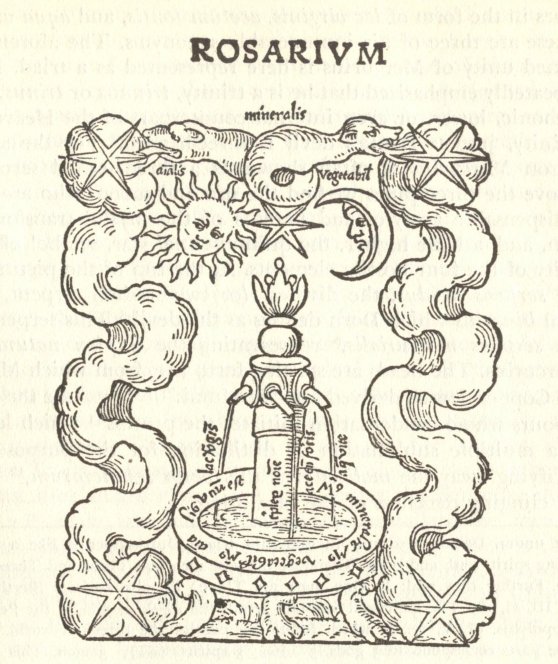
Symbolism - Jackie
The Mercurial Fountain. This first image symbolizes
the deep, cosmic, reptilian and elemental foundation of the psyche. We can read
some of the symbology to see how the alchemist
depicted this very deep autonomic ground of being. It is called the Mercurial
Fountain, or Fountain of Mercury, the venue for the mysterious, transformative
work to be undertaken by the alchemist. Mercury is the universal alchemical
symbol for yin, the feminine moist principle, bodily fluids and the element of
water. Water has always had the symbolic power to cleanse and make holy. The
basin contains water, like a uterus in which new life is created. Out of the
water rises a fountain with three spouts representing three manifestations of
Mercury, The water of life, Virgin's milk, and the bitter fount of vinegar.
Above the fountain we see the sun and moon, symbols of our masculine and
feminine parents. This is all surrounded by a 2 headed serpent on top, each
head spouting a vapor, from an ancient idea that the four elements first
derived from two vapors and then the 4 basic elements of creation, fire, water,
earth and air, depicted by the 4 stars in each corner. There is a fifth star in
the center which is created by the union of the 4. This picture symbolizes the
deep unconscious wholeness, the alchemical prima materia,
where the transformation of the individual can take place.
In My Life - Barbara
In October of 1978 I suffered a severe post partum depression for which I was hospitalized. I was
able to return to my job and my life, but for years I remained unhappy, with
deeply held feelings of self-hate and worthlessness. This was in spite of
having a good job, a wonderful, supporting home and family. In April of 1986
after having been in this unhappy state for some time, I decided to enter a
deeper exploration with my psychiatrist to understand what was behind my
unhappiness and make any changes in my life that were required. The image of
the Mercurial Fountain looks and feels to me like the scary, electric place
full of significant possibilities that I found myself in at the beginning of
this analysis.
The Second Image: The
Opposites Appear, the King and Queen

Symbolism - Jackie
We now see that the original unity has been split into two of the opposites,
The King and Queen, who approach each other. They stand respectively on the Sun
and the Moon, indicating the masculine solar nature and the feminine lunar
nature. They give each other their left hands, signifying the unconscious
nature of the union that is to be made. They extend their right hands toward
each other, holding branches with two flowers each, representing the four
elements. A fifth flower comes from the beak of a dove representing the Holy
Spirit who descends from a star. Jung describes this picture as symbolic of an
unconscious transference relationship between a male analyst and a female
client. This relationship becomes the vessel to hold the work of transformation.
In My Life - Barbara
When I began analysis with my psychiatrist, I was not conscious of the animus,
anima, or all the possible relationships between us conscious and unconscious.
The only one that I was definitely aware of was between our two conscious selves.
I respected and admired him and his seemingly magical way of being able to pull
me out of depression - using psychoanalysis and drugs. Looking back on the
situation, I realize that there was unconscious communication going on; I'm
pretty sure that he could pick up on my unstated trust and faith, in him and my
wanting to be liked by him. I sensed his feeling of confidence and optimism
that this therapy would work, and the feeling of competence and importance that
gave him. I was aware that he practiced Yoga faithfully every day and I'm
pretty sure that there was some unconscious communication of this spiritual
attitude to me. At the time this analysis started, I hadn't gone to church in
20 years and I had no spiritual practice.
The Third Image: The
Naked Truth

Symbolism - Jackie
The man and woman now face each other without wearing clothing. Their banners
indicate that they expect to be married. This stands for the situation where
there is sufficient trust, and loving acceptance of each other for the patient
to "undress" for the analyst and to share the truths which lie behind
her persona. The star has disappeared and the flowers they hold make a star
between them and the dove. This indicates that a transpersonal dimension has
been reached and a spiritual energy has been constellated in the human vessel
of the relationship,
In My Life - Barbara
Near the beginning of the analysis, I remember telling my psychiatrist that the
real truth between my parents and me was that they would love me no matter what
I did; that their love was unconditional. I had never realized that before,
because pleasing them had been my way of life since as early as I could
remember. He told me that he believed that was true, and that we could start
working on this issue first. Telling him something so elemental, important, and
uncharacteristic of any of my prior thoughts or behavior was exposing a truth
behind my persona. It felt like "undressing", as illustrated in this
image.
The Fourth Image:
Immersion in the Bath

Symbolism - Jackie
The King and Queen have now descended and are sitting
in the waters of the Mercurial fountain, the mysterious unconscious psyche. The
client "begins to feel the full comfortable and contained in the analytic
situation". The solidly ordered structure of her ego is being questioned
and begins to loosen.
In My Life - Barbara
I worked very hard at the analysis. I felt it was the most important thing that
I was doing, and would show me a way to live my life free of self-hate, being
who I was meant to be. That is, I was discovering who I was so that I could
freely be that person. Although we weren't doing "Jungian analysis",
the goal was definitely what I now understand to be individuation, as Jung
defined it. I began to get glimpses that this goal was at least partially
possible. I was fully immersed in the unconscious bath and actively challenging
myself as bravely as I could. There was definitely a feeling of forward motion,
that this process was irreversible.
The Fifth Image: The
Conjunction, Union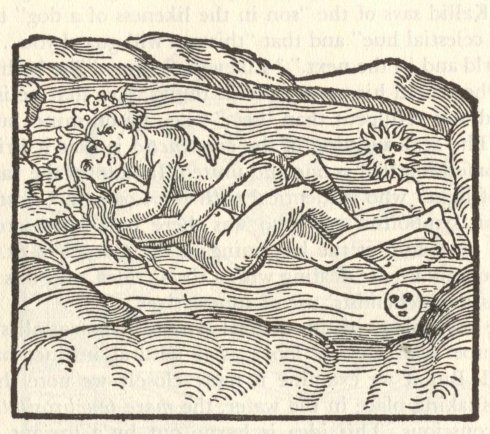
Symbolism - Jackie
The King and Queen are now under water and are engaged
in sexual union. Dr. Edinger points out that we
really are not supposed to see this, it is a sacred mystery of the unconscious
depths. In the ancient mystery schools the sacred union was known as the heiros gamos and celebrated as
the high point followed by the birth a holy child. In therapy we see here in
the transference of feelings, the unconscious experience of connection or
intimacy between the analyst and client.
In My Life - Barbara
After we had been working for some weeks, my psychiatrist asked me if I did
something spiritually for myself. I said I didn't. He asked me if I would like
to learn how to meditate because many people find meditation to be very helpful
in calming themselves. I agreed, ready to try anything new in this process. He
taught me meditation. I read a book about meditation that he gave me, but I
didn't start meditating regularly.
Because I unconsciously
believed that my psychiatrist had magical powers, I began to entertain the
possibility that maybe my old way of looking at spiritual things was wrong, and
this new way was right. This wasn't a conscious process, but I believe this is
what was going on in my unconscious mind. This was the unconscious union
between him and me. Not too long after this, I found myself spontaneously
happy. My psychiatrist was happy for me, and told me my happiness came from
inside me, something that I immediately believed, and still believe today. Not
long after this, I had a vision of seeing halos above the heads of some of the
"least significant" people in a meeting at work. I saw this as a
vision from God giving me an important truth about the world. This vision
turned my life around. I was elated, in fact manic, although I didn't know that
at the time. I told my psychiatrist that I was cured and didn't need to see him
again. I believe he had a countertransference reaction, picking up on my
elation and was pleased at the role he played in my 'recovery'. He bid me
adieu. Since I was 'cured', I stopped taking my psychotropic medication.
Neither of us knew that this was only midway in the process of my
individuation.
The Sixth Image: Death
in the Tomb
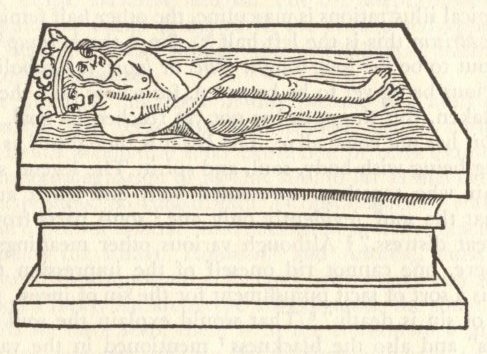
Symbolism - Jackie
The King and Queen are dead and have melded into a
single being with two heads and one large crown. Both masculine and feminine
aspects of the being are explicitly present lying in a sarcophagus filled with
water. Some marriages stay in this unconscious union for a lifetime. However,
if and when you discover that you have lost your identity that is a terrible
blow to the ego and is experienced as death. When it becomes conscious this is
represented in dreams as the death of some figure. It does not usually mean
literal death but a large attitudinal change. The old governing principles of
the ego are going to be modified or altered.
In My Life - Barbara
About a week after I ecstatically bid a "final farewell" to my
psychiatrist and stopped taking my medication, I began to get the clear feeling
that I was going to die. This feeling became stronger and stronger. I woke up
in the early hours of the morning after having dreamt I was dying. Soon, these
ideas came during my waking hours as well. Finally, one day while at work I
became convinced that I would die that day. I shared these thoughts with a
friend, who became alarmed when he couldn't reason with me, and he called my
husband. My husband and my friend took me to the psychiatric hospital where I
was involuntarily committed. As I entered the hospital, I was smiling broadly,
believing I was entering heaven and would become a soul to be reborn. I became
close to catatonic, believing I was in a tomb. After I recovered, I wondered
for a long time how I ever got the idea of death. None of the hospital
psychiatrists could make anything out of it, and my own psychiatrist was out of
town. Jung's use of the Rosarium Philosophorum
image of a metaphoric death during analysis fits this situation very well.
The Seventh Image: The
Ascent of the Soul
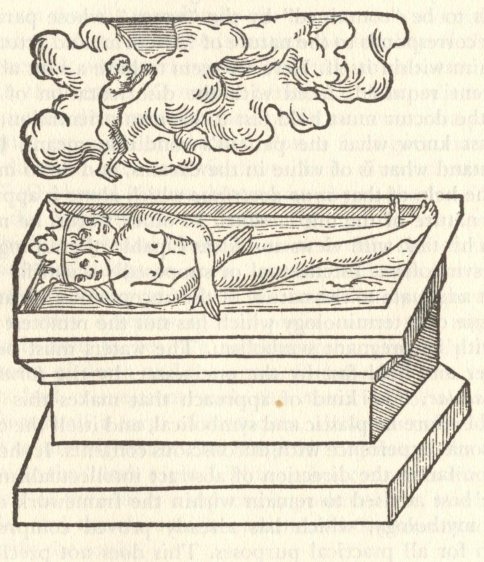
Symbolism - Jackie
Now the tiny Divine Child, an age old symbol of the soul, is seen separating
from the body at the moment of death. The child ascends into the cloud, an
ageless symbol of the Divine.
This identity loss of
the ego is serious enough to bring about a serious reevaluation of the
structures of the personality. "There is a collapse of the existing
ego-consciousness. It is closely analogous to the schizophrenic state, and it
should be taken very seriously because this is the moment that psychoses may
become acute. This collapse and disorientation is one of the most difficult
transitions the analyst has to deal with, demanding the greatest patience,
courage, and faith on the part of both doctor and patient...This critical state
is akin to the "loss of soul" that frequently attacks
primitives." The "old structures that upheld an earlier sense of
identity must give way for an anew psychological orientation"
In My Life - Barbara
I clearly believed my soul had departed my body and was awaiting rebirth. To
the mental hospital, I was psychotic. They could clearly see that I wasn't
dead, even though I thought I was. The other patients were waiting to be
reborn, also, but the staff members weren't.
It is very significant
and interesting to me that Jung describes this stage of analysis as being
dangerous in that one can loose contact with reality
and the "psychoses may become acute." Although I knew nothing of this
theory, this is precisely what happened to me at this stage of analysis. I
certainly had lost contact with the commonly accepted form of reality, and at
that point I had no guide to help me through it.
The Eighth Image: Purification
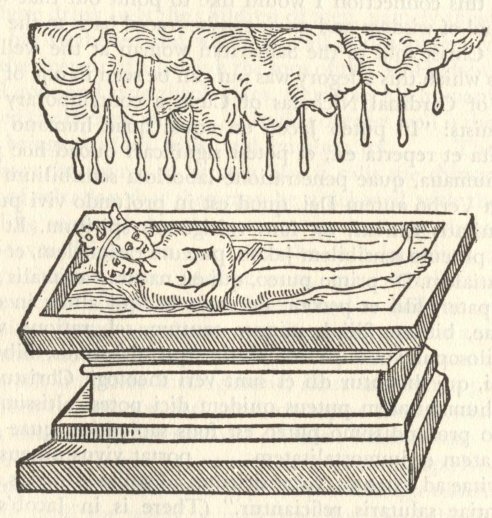
Symbolism - Jackie
Here we see Heavenly dew is falling on the grave. The dew is that miraculous
water from heaven which will purify and revive the dead body, which, remember
is psychologically her dead ego. The patient realizes that she has projected
her authority onto others and is now learning "that what she sought
outside herself must be found within, not only intellectually, or practically,
but with new feeling, a loving relationship toward and acceptance of
herself." The falling dew symbolizes the realization in the client of the
change which is happening and the hope of resurrection and new life which it
brings.
In My Life - Barbara
As I began the role of patient in the psychiatric ward, including medication
and therapy, I started to engage with other patients who I at first thought
were other souls waiting to be reborn as I was. As the days went on and the
medication began to take affect, I remember telling
one of the psychiatrists that I was "starting to see some evidence ... " that I was alive. I remember him laughing and
showing off that he could accurately throw a paper wad into the waste basket on
the other side of the room. The psychiatrist explained that "people just
don't get better this fast from having visual and auditory hallucinations."
I realized that he didn't know what was happening with me. I think the doctors
were happy when my psychiatrist returned from vacation. He told me he hadn't
expected to see me there and clearly he felt bad because one of his
"successes" had unraveled so quickly.
The Ninth Image: The
Return of the Soul
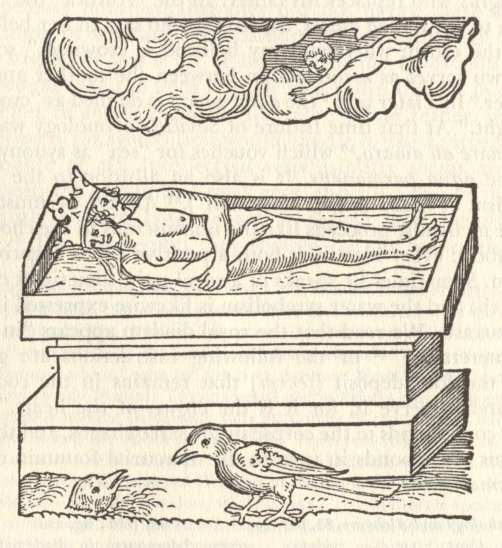
Symbolism - Jackie
The soul dives down from heaven to breathe life into the dead body which has
been purified. At this point in the analysis, the patient has the task of
reconstructing her conscious personality after her experience of the death of
the ego. Jung realized that to live in this world, the rational person must
learn to live in space and time with others in society. At this point, the
analyst will help the patient actualize her new sense of Self,
validating her own feelings and experiences in order to reconstruct the
personality.
In My Life - Barbara
I stayed in the hospital for three weeks, gradually spending more and more of
the day at home with my family, and returning at night to the hospital. I
regained a sense of self and sanity - that I was returning to some form of
life, but as a changed person. I didn't care as much for many of the things
that I had previously valued - status, possessions, good regard of others. I
started attending church for the first time in 20 years and for the first time
let spiritual ideas take an important role in my life. I learned how to weave,
which remains my main form of creative artistic expression. I became a more
complete person. Through all of this, I had regular sessions with my
psychiatrist. He was encouraging and positive, but also realistic and
challenged me when I needed to be challenged. I wasn't as fragile as I had been
before, and his criticism didn't wound me - I took it as constructive. My soul
had returned.
The Tenth Image: The New
Birth

Symbolism - Jackie The new united body, combining both King and Queen is now
alive and erect, standing on the moon above the earth. It is a winged Being
representing spirituality. In her right hand is a chalice of three snakes and
in her left one a loose snake. All are crowned. Dr. Edinger
says that perhaps this alludes to our reptilian psyche, our ground of being,
which has been visited and transformed. Out of the earth on the left a sun moon
tree is coming from the earth and on the right stands a bird, symbol of spirit.
The new consciousness that emerges has brought together a new synthesis of
opposites, enlarging her sense of Self so as to be at home with both aspects of
her masculine and feminine self, her humanity and divinity, her ground of being
and her spirituality.
In My Life - Barbara
The process of rebirth for me has been an ongoing journey. I have established a
strong presence of spirituality in my life and have learned to value my
nurturing, creative side. A stint as a member of the faculty on loan to a
minority university taught me the blessings of a life of service. This
experience led me to start a group to help others with mental illness, and that
in turn led me to enter seminary with the goal of helping the mentally ill. I
now have a healthy relationship with my animus and value both masculine and
feminine parts of my nature. Comparing myself now to who I was before I began
analysis, I have definitely been reborn.
Conclusions
When I first read Jung's
book The Psychology of Transference, I had no idea how closely my own
experience would follow the psychological process I had been through. For
years, after my experience with "death", I sought to understand what
had happened. My own psychiatrist didn't know, or wouldn't tell me. The other
psychiatrists seemed to be baffled and I couldn't find anything written about
it. The closest description came from my dream-work professor Jeremy Taylor who
told me that death in dreams usually signifies a transformation in one's
personality.
Clearly, there is
something universal and archetypal about the stages one goes through in the
process of individuation; I had no knowledge of this aspect of Jung's work
until now, 16 years after the fact, and yet I can see that I was exhibiting
classic behavior of each of the stages in the order specified. This includes
becoming psychotic at the exact stage that Jung says one can become psychotic!
I find this very remarkable, and uncanny. Until I wrote this paper for my
class, I hadn't realized the degree to which archetypes can be acted out
without the person's knowledge, and can be a very accurate picture of what is
really going on. This stuff is real. I wonder why none of the psychiatrists
seemed to know what was happening. Clearly, they weren't Jungian analysts!
I am very glad that I
had the opportunity to make this exploration using Jung's metaphor of the
psychoanalytical process from the Rosarium Philosophorum. It is the clearest and most helpful
explanation of my experience that I have gained to date.
Lest my tale scare
someone here from considering therapy, I need to tell you that most people
undergoing the process of individuation do not end up in the psychiatric ward
thinking they are dead. Mine was a particularly literal way of acting out this
rebirth process. Most people undergo a transformation in a much more subtle way
than I did, but they too are changed in deep and significant ways.
From this example of
Jung's work, I think you can see that his religious sense came from exploring
the inner lives of people, helping them to discover their own inherent
spiritual beings. This is certainly what happened with me.
Benediction by Jackie Porter
Barbara:
Who of us knew the high cost of what it meant
to cry out for wholeness?
Yet each of us walks into the darkness
of our own cave
knowing it is our true path
and our unique destiny.
Jackie:
Listen and tell your own story.
Find the melody and sing your own song.
You will rekindle the spark
hidden in the darkness,
it will light the way home for us all.